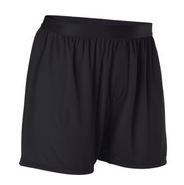Bunching
It’s hard to say which is worse – bunched up skiing, or bunched up underwear, and although both are unpleasant, bunched up skiing is definitely more dangerous. You usually hear about the dangers of bunching up in two scenarios; either in an avalanche course where the instructors say to avoid it, or when there’s been an avalanche accident with multiple fatalities where spreading out might have saved lives.
Not bunching up, aka spreading out, is one of those things that everyone agrees is a great idea, but in reality it can be very hard to achieve for a variety of reasons. Personally, I think knowing when and how far to spread out is one of the true hallmarks of an experienced backcountry skier as it takes a certain amount of awareness, patience and good group dynamics to achieve it. Conversely, it is very common to see groups of fast, hard charging skiers all packed together like a biking peloton going straight up the center of avalanche paths. They are obviously strong and fit, but probably haven’t been touring for very long or they’d know better.

7/8ths of an inch is probably a bit tight on spacing…
One of the trickier things about spreading out is knowing when to do it, as it is not absolutely necessary most of the time, at least in terrain like the Wasatch where you might be skinning through a forest or along a ridgeline. To be ultra safe you should probably start spreading out right as you leave the trailhead, but that’s not very social and creates issues of its own when you have a group of four spread out over a mile. As far as skiing down goes, there is pretty much no reason not to spread out, except if you are in a huge group, which is a problem all of its own.

Couloirs are a special spacing situation as regardless of how far apart you are, there is still a chance of getting mowed down like bowling pins. Because of this, I prefer to stay off to the side while hiking them as much as possible. That said, sometimes the debris/sluff pile that runs down the center can have the firmest snow.
My personal theory on the root cause of bunching is that people tend to go out with others of similar mindsets and abilities. Where the dangerous part comes into play is when the leader is slowed down by breaking trail or by technical terrain and the rest of the group, without even being conscience of it or hurrying, floats up from behind and inadvertently packs in. A lot of times if the conditions or terrain seem safe enough, I either won’t say anything (assuming I’m in the lead), or say something along the lines of “Hmmm, we should probably space out a bit here.” This comment is usually good for about 50′ and five minutes, after which the group has mysteriously rebunched. I only say this as I’ve been guilty of doing this myself many, many times, and it always seems accidental – I’m not trying to bunch up, it just happens. Breaking trail can be a slow, arduous process and if you are out with a group of equally fit people, the leader is going to be going half speed while those bringing up the back are coasting along at at full speed.

I’d consider this appropriate spacing for the terrain.
If you were to look at a still photo of a tightly packed touring group, the obvious solution might be that all of the trailing skiers should slow down and bit and spread out, but lately I’ve been taking just the opposite tack – if I’m leading and uncomfortable with spacing, I’ll pull aside, let people pass and fall in behind. The person who is out front breaking trail has control over route selection and pacing, but it is the people behind who have control over the spacing. It’s hard to have it both ways, but if bunching is becoming an over-riding concern, the best way to control it is from the rear of the line, not the front. If I’m out skiing with a strong group where everyone is continually pushing to the front, it takes some inner zen to drop to the back in the name of spreading out, even if you feel like a slacker for not taking your share of trailbreaking. It is not a bike race where the leader has to be immediately replaced once he/she needs a break.
Ideally, everyone would spread out and also take turns trailbreaking, or someone who is feeling their oats would break trail all day, but those scenarios don’t seem to happen all that often.
________________________________
Help support StraightChuter.com and at least avoid bunched boxers with a pair of Patagonia Silkweight Solid Boxers from Backcountry.com. Click on the photo below…
Category: 07 Avalanche Avoidance, Avalanche









